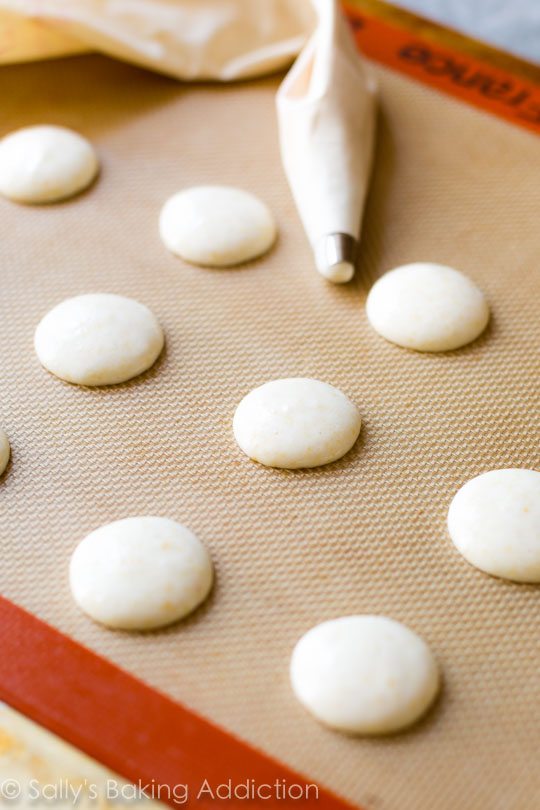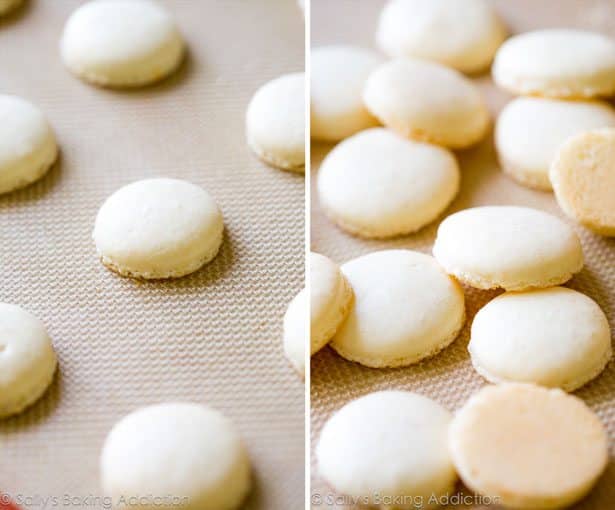
French macarons are delicate cookies with a crunchy exterior and weightless interior. If there’s one thing to know before beginning French macarons at home, it’s this: these cookies are not simple. Impossible? Absolutely not. Requiring BOTH patience and practice? Yes.
That’s why they’re so expensive in bakeries and restaurants! These are quite particular little cookies, as I’m sure you already guessed. I’m not saying this to intimidate you– I’m saying this to prepare you for a French macaron journey. Let’s get started. You can do it.
Updated Recipe
Before you read more about this particular recipe, I want to mention that I have an updated and more reliable recipe for French macarons published. In the newer recipe, I have an additional 6 years of practice and am much more confident with the consistency of results. Feel free to try these, but I like my newer French macarons recipe better. It also includes a video.

A kitchen scale is required for the best results. I’m actually encouraging you to NOT use US cup measurements for this recipe, as there is way too much room for error. Whenever I made macarons based off of cup measurements (2/3 cup this; 3/4 cup that), I messed up the cookies every single time. They tasted “fine” but not authentic. And they didn’t look very pretty, either.
The base ingredients for these French macaron cookies are almond flour, confectioners’ sugar, and room temperature egg whites. You can make your own almond flour at home by pulsing blanched, skinless, unsalted, raw almonds until fine. However, buying a package is easier and you get the super-fine texture needed for macaron batter. I like Bob’s Red Mill brand. I find this in my regular grocery store in the baking aisle.
Almond flour and confectioners’ sugar is blended together in a food processor or blender until thoroughly combined and fine in texture. Like this:

Then beat 3 room temperature egg whites until stiff peaks form. Make sure the egg whites are at room temperature. In fact, separate the egg whites in advance. Then, let them sit out for a few hours or even overnight. They need to “age.”

Left: Stiff peaks. Right: sifted granulated sugar. Sifted being the key word here. The last thing you want are coarse granules of sugar in your airy, light macaron cookies.
Lightly beat the sifted sugar into the egg whites then fold in the almond flour/confectioners’ sugar blend. Slow slow slow folds. Always be gentle with macaron batter.

The batter will be thick, off-white, glossy, and sticky.

Now it’s time to pipe the batter onto baking sheets.
I tested macarons on parchment paper, bare non-stick sheets, and silicone baking mats. Silicone baking mats were BY FAR the easiest surface to work with. I found the macarons spread a little more on the bare non-stick sheet surface, as well as the parchment paper. Using either surface also made it a little more difficult to remove the delicate cookies.

The macaron batter is piped onto baking sheets. It took me a lot of practice to get those perfect little circles and, trust me, each one still isn’t perfect. You will need a pastry bag fitted with a round tip—I usually use Ateco 806 (size 6) 1/2″ plain tip.
Pipe small rounds. The macaron batter will slightly spread, so start with only a little bit. You want the rounds to be around 1.5 inches in diameter.
Before baking, let the piped rounds sit. Just as you let the egg whites come to room temperature, the batter rounds need time to “age” as well. This is crucial to making macarons. Time is macaron batter’s best friend. During this time, the air will will help the rounds set and form a dry shell. Meaning, they will no longer be wet and sticky, which helps the cookies rise up and create those familiar ruffled feet at the bottoms. I always let mine sit for at least 45 minutes.
Then, bake the cookies:

The cookies take around 10 minutes in the oven. The tops will be crisp, the bottoms will develop their trademark crinkly feet.
Allow them to cool, then fill with your favorite fillings/frostings.

Here I use my basic vanilla frosting. You can tint the frosting any color you like OR you can use other fillings. I list several in the recipe notes below, so there’s plenty to choose from.
Be sure to read through all of the recipe instructions before you begin so you know the what, when, where, and why’s of the recipe. Also, read my Quick Tips for Success below. You’re guaranteed better success doing both.

You can also try these Salted Caramel Cinnamon Macarons:
Dust your piped macaron shells (before drying in step 7) with ground cinnamon. Fill your macarons with salted caramel buttercream. For the buttercream, you need 1/2 cup (115g) softened unsalted butter, 1 and 1/2 cups (180g) confectioners’ sugar, 1 teaspoon pure vanilla extract, and 1/3 cup (80ml) store-bought or homemade salted caramel. To make the buttercream: In a medium bowl using a hand-held or stand mixer fitted with a paddle or whisk attachment, beat the butter for 1 minute on high speed until completely smooth and creamy. Beat in the confectioners’ sugar until combined and creamy, then beat in the vanilla extract. Gently fold in the salted caramel until mostly combined.


Basic French Macarons
- Prep Time: 2 hours
- Cook Time: 10 minutes
- Total Time: 2 hours, 45 minutes
- Yield: 40 shells / 20 filled macarons
- Category: Dessert
- Method: Baking
- Cuisine: French
Description
For best results, use a scale to measure these ingredients in grams
Ingredients
- 200g confectioners’ sugar (close to 2 cups)
- 100g almond flour (close to 1 cup)
- 120g room temperature egg whites (around 3–4 large egg whites)
- 1/8 teaspoon salt
- 40g sifted granulated sugar or caster sugar
- flavoring or color
- your desired filling
Instructions
- Place the confectioners’ sugar and almond flour in a food processor or blender and pulse or blend for 30 seconds until thoroughly combined and fine in texture. Set aside.
- In a completely dry and grease-free bowl, beat the egg whites and salt together on medium speed for 1 minute. Switch to high speed and beat *just* until stiff peaks form, about 3 minutes. Do NOT overbeat. Using a metal spoon or rubber spatula, gently fold in the sifted granulated sugar, 1 Tablespoon at a time.
- On low speed, beat in any flavor or color at this point. Do not overmix.
- Using a metal spoon or rubber spatula, fold in the confectioners’ sugar/almond flour mixture until combined. Be very gentle and light-handed while doing so. Once completely combined, the mixture will be smooth, sticky, and glossy.
- Let the batter sit uncovered at room temperature for 10-30 minutes. Meanwhile, fit your piping bag with the piping tip. Line 2-3 baking sheets with silicone baking mats.
- Fill the piping bag with the batter and pipe evenly sized rounds onto the baking sheets—make sure you are holding the bag vertically and close to the baking sheet. While piping, the batter will slightly spread out, so keep that in mind. You want around 1.5-inch circles. Gently tap the bottom of the baking sheets on your counter to rid any large air bubbles. You can lightly sprinkle a few sprinkles, a dash of cinnamon, or any edible decorations onto the wet round shells at this point.
- Let the piped rounds sit for at least 45 minutes and up to 1 hour. This is crucial to making macarons! The air will will help the rounds set and form a dry shell. They should not be sticky going into the oven.
- Preheat oven to 325°F (163°C). Bake the macarons for 10 minutes, one baking sheet at a time. Rotate the pan at the 5 minute mark. The tops should be crisp and the macarons should have formed their signature crinkly “feet.” Allow to cool completely on the baking sheet before filling.
- Fill* and sandwich two shells together to form an iconic French macaron cookie! Leftover macarons keep well covered at room temperature or in the refrigerator for up to 1 week.
Notes
- Special Tools (affiliate links): Food Processor | Electric Mixer (Handheld or Stand) | Glass Mixing Bowls or Metal Mixing Bowls | Egg Separator | Food Scale | Fine Mesh Sieve | Piping Bag (Disposable or Reusable) | Medium-Round Piping Tip (Wilton 12, Wilton 1A, or Ateco 806) | Baking Sheets | Silicone Baking Mat, Macaron-Specific Silicone Baking Mat, or Parchment Paper
- Egg Whites: Age your egg whites. Separate them first. Then, cover and refrigerate for 12-24 hours. Bring to room temperature before starting.
- When coloring or flavoring macaron batter, remember that less is more. Too much addition to the light batter equals a change in texture and appearance. I find a half teaspoon of any flavor extract is enough for the entire batter, as well as only 1-3 drops of liquid/gel food coloring. You can also use food coloring paste. I used 1/2 teaspoon almond extract in the pictured macarons. I also tinted one batch peach with 1 drop pink liquid food coloring and 1 drop yellow liquid food coloring.
- Filling Ideas: I used very vanilla frosting in these photos. To get blue, I tinted with 1 drop blue liquid food coloring. You can also use strawberry frosting, jam, salted caramel, milk chocolate frosting, dark chocolate frosting, coconut frosting, apple butter, or cooled chocolate ganache
- Adapted from Les Petits Macarons and Mad About Macarons.
Quick Tips for Success
- If your macarons aren’t perfect, that’s ok! Don’t give up just yet. Practice makes perfect. It took me awhile too.
- Make sure you weigh all of your ingredients before beginning. You might think this is unnecessary but, if you read anything in today’s post, you know it’s crucial.
- Overbeating the egg whites will introduce more air and create an airy, hollow cookie. Avoid overbeating. Only beat *just* until stiff peaks form. Here is a GREAT post from Ms. Humble on avoiding hollow centers.
- Always handle macaron batter with finesse and care. Mixing and folding too much? All will be lost!
- Avoid making your macarons on a particularly humid day. Right now in the summer, look for the day of the week with the least humidity. Cool, dry weather is best.
- Macaron rounds should be dry going into the oven. That is why letting them sit at room temperature for at least 45 minutes (the longer the better) is imperative.
- Take notes as you go. I suggest this because if you run into any problems, you can refer to your notes to make adjustments such as, letting the egg whites age longer, turning up/down the oven temperature, using a different baking sheet, etc.



















